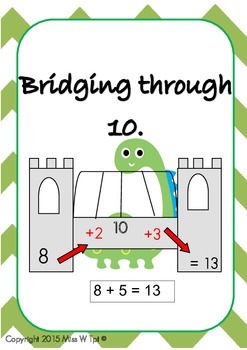Bridging To 10
If your child is just learning the basics of mathematics, you may have heard of the concept of "bridging to 10". But what does this mean, exactly? And why is it an essential skill for your child to master? In this article, we will take a deeper look at bridging to 10 and its importance in early mathematics education.
Pain Points of Bridging to 10
Many children struggle with basic addition and subtraction, especially when it comes to numbers higher than 10. In many cases, this can lead to frustration and a lack of confidence in their abilities. Without a solid foundation in early mathematics, children may struggle with more advanced concepts later on.
What is the Target of Bridging to 10
Bridging to 10 is a technique that helps children visualize numbers in a way that makes addition and subtraction easier. Essentially, it involves breaking down numbers into smaller parts to make them easier to work with. For example, if a child is trying to add 7 + 5, they can break down 5 into 2 + 3 and then add the 2 to 7 before adding the remaining 3, resulting in 10.
Summarizing Bridging to 10
In summary, bridging to 10 is a critical skill for young children to develop. By breaking down numbers into smaller parts, children can visualize and understand basic addition and subtraction more easily. This lays the groundwork for more advanced math concepts down the line.
Benefits of Bridging to 10
Bridging to 10 is a fundamental skill for young children that offers a range of benefits. By helping children visualize and break down numbers, it builds their confidence and makes math less intimidating. It also helps to lay the foundation for more complex math concepts such as multiplication and division.
Personally, I've seen firsthand how bridging to 10 can make a difference in a child's understanding of math. My son was struggling with basic addition, but once he learned how to bridge to 10, he was able to approach math problems with more confidence and ease.
How to Teach Bridging to 10 at Home
Teaching your child to bridge to 10 is easier than you might think. One of the easiest ways to introduce the concept is to use visual aids such as number charts or blocks. Start with simple addition problems and gradually work up to more complex ones.
If your child is struggling, try breaking down the numbers into smaller parts and practicing with those first. Be patient and encourage your child to keep trying - with practice, they will master this essential math skill in no time.
Understanding Bridging to 10 in More Detail
Breaking numbers down into smaller parts is an excellent way to help children understand and visualize basic addition and subtraction. It can also help them build their problem-solving skills and increase their overall confidence in math. Ultimately, bridging to 10 is an essential tool that can set your child up for success in mathematics and beyond.
Tips for Mastering Bridging to 10
If your child is struggling with bridging to 10, try incorporating games or other fun activities to make learning more engaging. Use visual aids such as number charts or blocks to help reinforce the concept. And most importantly, be patient and encouraging - with practice, your child will get the hang of it!
Question and Answer
Q: How can I tell if my child is struggling with bridging to 10?
A: Look for signs of frustration or confusion when working on addition or subtraction problems. If your child is struggling to visualize numbers and break them down, they may need additional support.
Q: What are some fun activities I can use to help teach bridging to 10?
A: Try incorporating games or puzzles that involve breaking down numbers into smaller parts, such as Sudoku or math crossword puzzles.
Q: How can I incorporate bridging to 10 into my child's daily life?
A: Look for opportunities to practice basic addition and subtraction together throughout the day, such as counting items or adding small amounts of money. You can also use flashcards or other visual aids to reinforce the concept.
Q: What are some other basic math skills that are important for children to master?
A: Other fundamental math skills include counting, number recognition, and basic operations such as addition and subtraction. These skills lay the groundwork for more complex math concepts later on.
Conclusion of Bridging to 10
Bridging to 10 is a crucial skill for young children that builds their confidence and helps them approach math with greater ease and understanding. By breaking numbers down into smaller parts, children can visualize and understand even complex math problems more easily. With practice and patience, your child can master this essential math skill and set themselves up for success in mathematics and beyond.
Gallery
Bridging To 10 - Addition - YouTube

Photo Credit by: bing.com / bridging addition
This Engaging IWB Lesson Will Help Your Students To Understand The

Photo Credit by: bing.com / bridging strategy ten decades bridge adding students choose board iwb engaging understand lesson help
Adding To Bridge 10 | Teaching Resources

Photo Credit by: bing.com /
Bridging Through 10 Addition By Miss W TpT | Teachers Pay Teachers

Photo Credit by: bing.com / bridging through addition strategy bonds teaching ten maths bridge math year grade number activities teacherspayteachers ks1 using visit choose board
Bridging - YouTube
Photo Credit by: bing.com / bridging